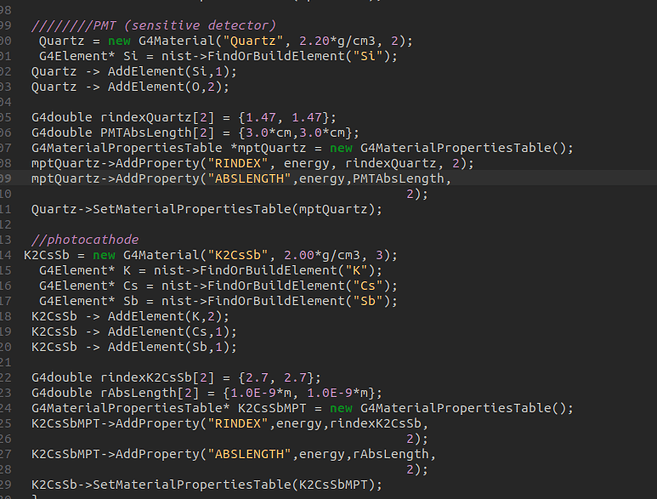Hello everyone
I was trying making a NaI Scintillator detector. Scintillator is made up from NaI, photocathode from K2CsSb and PMT from Quartz. But while running, the rays are getting confined to Scintillator only. But when I change the material of photo cathode and PMT to NaI, the ray travels inside the detector. What can be the issue.
Have you defined optical properties (e.g., refractive index, absorption length) for quartz and K2CsSb? If not, photons will not propagate through the photocathode and the rest of the PMT.
Thank you for your response. I have added the properties as seen in the screenshot attached. But the problem still persists. What can be the issue ? In fact the rays are stopping at PMT only, till photocathode they are travelling.
The absorption length in the photocathode is 1 nm, so assuming a typical thickness, no optical photons should get through to the remainder of the PMT unless they miss the photocathode due to geometry considerations (which seems unlikely given your figure above). This is what you would expect for a high efficiency photocathode. To test this, you can set the photocathode absorption length to a large value, say 1 m and run again. You should get lots of optical photons in the PMT.
Thanks for your reply. I changed it to 1 m but the result is still the same. ![]()
Thank you for your response. I have already defined skin surfaces. Maybe I will check it once again.
Is the vector “energy” used to define properties for the PMT and photocathode the same as the energy vector used to define the scintillator optical properties? If not, does the PMT and photocathode energy span the range of scintillator energies and do the values of the energy vector increase with element number?
Thanks for response Sir but I have kept the energy values same as of now. I wanted to just look at process visually at first. Also I changed my sensitive detector from photocathode to PMT, now the rays are travelling to PMT when I increased the absorption length but they are optical photons not electrons. In PMT, electrons should be there. But photocathode is not generating any of them. What could be the reason.
Surface of Cathode-PMT is dielectric-dielectric.
In a properly designed PMT, there should be a negligible number of optical photons getting past the photocathode.
You have not stated the energy range of your optical photons, but since the scintillator is NaI(Tl), I assume it is approximately 2.25 eV to 3.82 eV (325 nm to 550 nm). These photons are in the visible to soft UV wavelength range. Photoemission in that energy range is, obviously, highly material-dependent and I do not think that Geant4 optical physics includes such processes.
If you want to count the photoelectrons, it is probably more practical to set the photocathode as a sensitive detector and count the number and energy of the optical photons that arrive there. Using a published sensitivity curve for the particular photocathode, this can be converted into the number of photoelectrons emitted.
Modeling the complete electron transport in a PMT may be possible in Geant4 but would be very complicated to set up and I think there are more appropriate EM physics modeling packages out there to do it.
Alright Sir. Understood. I will try setting up photocathode as sensitive detector and then do the further process. Thank you so much for your time.
This topic was automatically closed 7 days after the last reply. New replies are no longer allowed.

